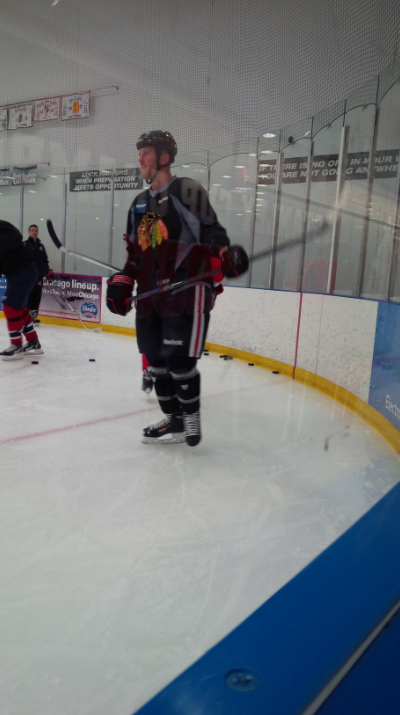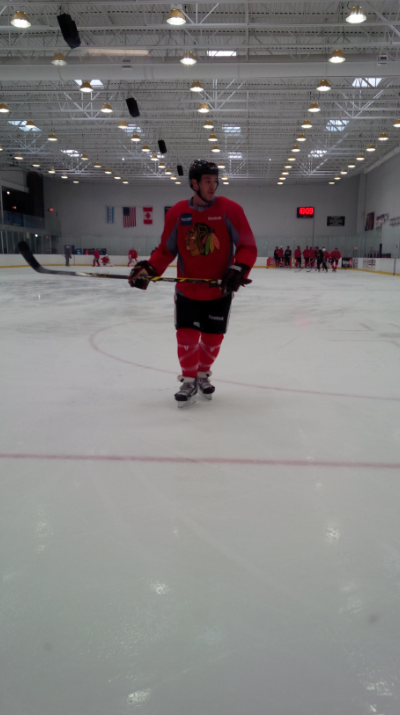Protecting Legs from Hockey Blades
Posted by Nate Puskaric on 09 23 2014
Hockey is an extremely physical sport. Unfortunately, due to the level of physicality, injuries are far from uncommon. Aside from the injuries caused by things like high impact collisions, pucks, and general physical exertion, some of the most gruesome injuries are caused when a blade connects with a lower leg.
The lower leg houses many vital components. The calf contains 2 different muscles. The larger of the two, known as the gastrocnemius, lies directly below the skin on the back of your leg. The smaller, known as the soleus, is more flat and lies beneath the gastrocnemius. At the bottom of the calf, these two muscles come together and are connected to the Achilles tendon by tissue. The Achilles tendon connects the calf muscles to the heel bone. This whole system is what allows your body to propel itself forward – fairly important in hockey. The lower leg also contains other important tendons, ligaments, and blood vessels, all of which are better off when they remain intact.
When a blade makes contact with even a small amount of force, it can easily cause damage. In a best-case scenario, only a skin laceration will occur. Oftentimes, damage is much worse. Slicing the Achilles tendon or cutting into the calf muscle can cause painful season or career ending injuries with implications that carry far beyond your time on the ice.
A well-known incident occurred when Matt Cooke stepped on the back of Erik Karlsson’s leg, effectively lacerating his Achilles tendon. Luckily, after surgery and intense rehab, Karlsson only missed 31 games.
In 2007, Kevin Bieksa had his right calf lacerated by Vern Fiddler. It took 47 games, over half the season, for him to return to the ice. Upon his return, he performed poorly, admitting that he had returned before his injury had fully recovered. He fell victim to another injury in 2009 when tendons above his left ankle were severed by the skate of Petr Prucha.
During the 2012-13 lockout, Eric Wellwood sustained a life threatening and career ending injury while playing for the Adirondack Phantoms. This forced him to retire at the age of 24.
These examples are only a few of the instances where lower leg injuries from blade contact have occurred. Many of these injuries can be avoided with the correct protective gear. Unfortunately, many of the Kevlar socks that have come to the market rarely protect against anything other than the “best-case scenario” injuries. Forceful impact with a blade will go through them just like it would without. Many players also complain that they are uncomfortable and restrict their level of play, choosing to not even wear them.
Fortunately, the guys over at Vital Nation noticed these issues and have developed a far superior protective sock. Their product, the Integral sock, includes a semi-rigid slash/cut resistant Kevlar padding that protects the back of the leg from the upper calf down to the Achilles tendon. Testing was performed adhering to standards set by the American Society for Testing and Materials (ASTM) and was rated by the American National Standards Institute/International Safety Equipment Association (ANSI/ISEA) at almost a 4 on a scale from 0-5.
The comfort issue has also been solved. The Integral sock does not interfere with a player’s natural range of motion, and is even starting to gain some attention from NHLers. We even caught a few of the Blackhawks wearing them at practice.


If you would rather not have to go through the pain and suffering of an injury like this, it might be worth looking into some protective gear. If you’re worried about how effective or comfortable they are, check out the Integral sock by Vital Nation. Keep your eyes peeled, more and more NHLers are starting to catch wind of this product, and it’s safe to assume you’ll see them more in the coming seasons.
